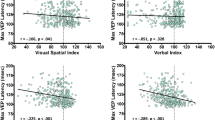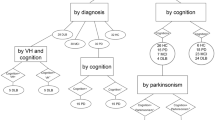Summary
The relationship between event-related potentials (ERPs) and cognitive functioning was studied in patients with Parkinson's Disease (PD) but without dementia. Auditory and visual stimuli were used; 30 subjects participated in the auditory study and 20 in the visual study. Patient groups did not differ with respect to gender, age, education, illness duration, and level of cognitive functioning. Visual stimuli were 2.3 cpd sinusoidal grating patterns randomly presented in an oddball paradigm (oblique vs. vertical spatial orientation). Auditory stimuli were tones presented at 70dB SPL at a rate of 1.1/second, also using the oddball paradigm (1.5K vs. 1K tones). All patients were given neuropsychological tests to measure verbal fluency, memory, visual spatial perception, and abstract reasoning. P300 and N200 abnormalities correlated with a number of these measures, such that longer ERP latencies were related to lower scores on tests of cognitive functioning. Patterns of results suggest that auditory and visual ERPs correlate with different subsets of neuropsychological functions in nondemented PD patients and that N200 may provide a new metric for clinical use.
Similar content being viewed by others
References
Antal A, Pfeiffer R, Bodis-Wollner I (1995) Concurrently recorded primary and cognitive visual evoked potentials distinguish younger and older patients with Parkinson's disease [Abstract]. Neurology 45: 638
Benton A, Hamsher K (1976) Multilingual aphasia examination. University of Iowa, Iowa City
Benton A, Hamsher K, Varney N, Spreen O (1983) Contributions to neuropsychological assessment: a clinical manual. Oxford University Press, New York
Bodis-Wollner I (1990) Visual deficits related to dopamine deficiency in experimental animals and Parkinson's disease patients. Trends Neurosci 13: 296–302
Bodis-Wollner I, Mylin L, Frkovic S (1989) The topography of the N70 component of the visual evoked potential in humans. In: Maurer K (ed) Topographic brain mapping of EEG and evoked potentials. Springer, Berlin Heidelberg New York Tokyo, pp 396–406
Bodis-Wollner I, Pang S, Falk A, Ghilardi M, Mylin L (1991) Vision and visual discrimination suffer in Parkinson's disease: evoked potential evidence. In: Bernardi G, Carpenter MB, Di Chiara G, Morelli M, Stanzione P (eds) Advances in behavioral biology, vol 39. The basal ganglia III. Plenum Press, New York, pp 743–750
Bodis-Wollner I, Yahr M (1978) Measurement of visual evoked potentials in Parkinson's disease. Brain 101: 661–671
Bodis-Wollner I, Yahr M, Mylin L (1984) Nonmotor functions of the basal ganglia. In: Hassler R, Christ J (eds) Advances in neurology. Raven Press, New York, pp 289–297
Bowen F, Burns M, Brady E, Yahr M (1972) A note on alterations of personal orientation in Parkinsonism. Neuropsychologia 14: 425–429
Bowen F, Hoehn M, Yahr M (1972) Cerebral dominance in relation to tracking and tapping performance in patients with parkinsonism. Neurology 22: 32–39
Brown R, Marsden C (1986) Visuospatial function in Parkinson disease. Brain 109: 987–1002
Canavan A, Passingham R, Marsden C, Quinn N, Wyke M, Polkey C (1989) Sequencing ability in Parkinsonians, patients with frontal lobe lesions and patients who have undergone unilateral temporal lobectomies. Neuropsychologia 27: 787–798
Cools A, Van Den Bercken J, Hostink M, Van Spaendonck K, Berger H (1984) Cognitive and motor shifting disorder in Parkinson's disease. J Neurol Neurosurg Psychiatry 47: 443–453
Fabiani M, Karis B, Donchin E (1986) P300 and recall in an incidental memory paradigm. Psychophysiology 23: 298–308
Funahashi S, Bruce CJ, Goldman-Rakic PS (1989) Mnemonic coding of visual space in the monkey's dorsolateral prefrontal cortex. J Neurophysiol 61: 331–349
Glover A, Ghilardi M, Bodis-Wollner I, Onofrj M (1988) Alterations in event-related potentials of MPTP-treated monkeys. Electroencephalogr Clin Neurophysiol 71: 461–468
Goldman-Rakic PS (1988) Topography of cognition: parallel distributed networks in primate association cortex. Ann Rev Neurosci 11: 137–156
Goldman-Rakic PS, Brown RM (1981) Regional changes of monoamines in cerebral cortex and subcortical structures in aging rhesus monkeys. Neuroscience 6: 177–187
Goldman-Rakic PS, Selemon LD, Schwartz ML (1984) Dual pathways connecting the dorsolateral prefrontal cortex with the hipocampal formation and the parahippocompal cortex in the rhesus monkey. Neuroscience 12: 719–743
Goodin D, Aminoff M (1987) Electrophysiological differences between demented and nondemented patients with Parkinson's disease. Ann Neurol 21: 90–94
Goodin D, Squires K, Henderson B, Starr A (1978) Age-related variations in evoked potentials to auditory stimuli in normal human subjects. Electroencephalogr Clin Neurophysiol 44: 447–458
Goodin D, Squires K, Starr A (1978) Long latency event-related components of the auditory potential in dementia. Brain 101: 635–648
Gotham AM, Brown RG, Marsden CD (1988) “Frontal” cognitive function in patients with Parkinson's disease “on” and “off” levodopa. Brain 111: 299–321
Hansch E, Syndulko K, Cohen S, Goldberg Z, Potvin A, Tourrellotte W (1982) Cognition in Parkinson's disease: an event-related perspective. Ann Neurol 11: 599–607
Homberg V, Hefter H, Granseyer G, Strauss W, Lange H, Hennerici M (1986) Event-related potentials in patients with Huntington's disease and relatives at risk in relation to detailed psychometry. Electroencephalogr Clin Neurophysiol 63: 552–569
Hovestadt A, de Jong G, Meerwaldt J (1987) Spatial disorientation as an early symptom of Parkinson's disease. Neurology 37: 485–487
Johnson R (1989) Auditory and visual P300s in temporal lobectomy patients: evidence for modality-dependent generators. Psychophysiology 26(6): 633–650
Johnson R, Litvan I, Grafman J (1991) Progressive supranuclear palsy: altered sensory processing leads to degraded cognition. Neurology 41: 1257–1262
Knight R (1984) Decreased response to novel stimuli after prefrontal lesions in man. Electroencephalogr Clin Neurophysiol 59: 9–20
Kraiuhin C, Gordon E, Stamfield P, Meares R, Howson A (1986) P300 and the effects of aging: relevance to the diagnosis of dementia. Exp Aging Res 12: 187–192
Levin BE, Llabre MM, Weiner WJ (1988) Neuropsychological correlates of early Parkinson's disease: evidence for frontal lobe dysfunction. In: Kalivas PW, Nemeroff CB (eds) The mesocorticolimbic dopamine system. Ann NY Acad Sci 537: 518–520
Lezak MD (1983) Neuropsychological assessment. Oxford University Press, New York
Mattis S (1976) Mental status examination for organic mental syndrome in the elderly patient. In: Bellak L, Karasu T (eds) Geriatric psychiatry. Grune & Stratton, New York, pp 79–121
Mortimer J, Pirozzolo G, Hansch E, Webster D (1982) Relationship of motor symptoms to intellectual deficits in Parkinson disease. Neurology 42: 133–137
Mulder G, Gloerich A, Brookhuis K, van Dellen H, Mulder L (1984) Stage analysis of the reaction time process using brain event-related potentials and reaction time. Psychol Rev 46: 15–32
Noldy N, Stelmack R, Campbell K (1990) Event-related potentials and recognition memory for pictures and words: the effects of intentional and incidental learning. Psychophysiology 27: 417–428
O'Donnell B, Squires N, Martz M, Chen J, Phay A (1987) Evoked potential changes and neuropsychological performance in Parkinson's disease. Biol Psychol 24: 23–37
Onofrj M, Ghilardi M, Basciani M, Gambi (1986) Visual evoked potentials in Parkinsonism and dopamine blockade reveal a stimulus-dependent dopamine function in humans. J Neurol Neurosurg Psychiatry 49: 1150–1159
Pang S, Borod J, Hernandez A, Bodis-Wollner I, Raskin S, Mylin L, Coscia L, Yahr M (1990) The auditory P300 correlates with specific cognitive deficits in Parkinson's disease. J Neural Transm [PD-Sect] 2: 249–264
Parsons O (1994) Neuropsychological measures and event-related potentials in alcoholics: interrelationships, long-term reliabilities, and prediction of resumption of drinking. J Clin Psychol 50: 37–46
Parsons O, Sinha R, Williams H (1990) Relationships between neuropsychological test performance and event-related potentials in alcoholic and nonalconholic samples. Alcoholism: Clin Exp Res 14: 746–755
Pirozzolo F, Hansch E, Mortimer J, Webster D, Kuskowski D (1982) Dementia in Parkinson's disease: a neuropsychological analysis. Brain Cogn 1: 71–83
Polich J, Ehlers C, Otis S, Mandell A, Bloom F (1986) P300 latency reflects the degree of cognitive decline in dementing illness. Electroencephalogr Clin Neurophysiol 63: 138–144
Raskin S, Borod J, Tweedy J (1990) Neuropsychological aspects of Parkinson's disease. Neuropsychol Rev 1: 185–221
Raskin S, Borod J, Tweedy J (1992) Spatial orientation and set-shifting in Parkinson's disease. J Clin Exp Neuropsychol 14: 801–821
Raskin S, Borod J, Wasserstein J, Bodis-Wollner I, Coscia L, Yahr M (1990) Visuospatial orientation in Parkinson's disease. Int J Neurosci 51: 9–18
Raven J (1960) Guide to the standard progressive matrices. Lewis, London
Sahakian B, Morris R, Evendon J, Heald A, Levy R, Philpot M, Robbins T (1988) A comparative study of visuospatial memory and learning in Alzheimer-type dementia and Parkinson's disease. Brain 111: 695–718
Selemon LD, Goldman-Rakic PS (1988) Common cortical and subcortical targets of the dorsolateral prefrontal and posterior parietal cortices in the rhesus monkey: evidence for a distributed neural network subserving spatially guided behavior. J Neurosci 8(11): 4049–4068
Shiu L, Pashler H (1991) Improvement in line orientation discrimination is retinally local but dependent on cognitive set. Invest Ophthamol Vis Sci 32 [Suppl 4]: 1041
Starr A, Barrett G (1987) Disordered auditory short-term memory in man and event-related potentials. Brain 110: 935–959
Stern Y (1983) Behavior and the basal ganglia. In: Stern Y, Rosen W (eds) The dementias. Raven Press, New York, pp 195–209
Squires NK, Donchin E, Squires KC, Grossberg S (1977) Bisensory stimulation: inferring decision-related processes from the P300 component. J Exp Psychol: Hum Percept Perform 3: 299–315
Tartaglione A, Pizio N, Bino G, Spadavecchia J, Favale E (1987) VEP changes in Parkinson's disease are stimulus dependent. J Neurol Neurosurg Psychiatry 47: 305–307
Taylor A, Saint-Cyr A, Lang A (1986) Frontal lobe dysfunction in Parkinson's disease: the cortical focus of neostriatal outflow. Brain 109: 845–883
Teuber H, Proctor F (1964) Some effects of basal ganglia lesions in subhuman primates and man. Neuropsychologia 2: 85–93
Wechsler D (1945) A standardized memory scale for clinical use. J Psychol 19: 887–895
Wechsler D (1981) Wechsler Adult Intelligence Scale-revised. Psychological Corporation, New York
Wilson R, Kaszniak A, Klawans H, Garron D (1980) High speed memory scanning in Parkinsonism. Cortex 16: 67–72
Yamaguchi S, Knight RT (1991) P300 generation by novel somatosensory stimuli. Electroencephalogr Clin Neurophysiol 78: 50–55
Author information
Authors and Affiliations
Rights and permissions
About this article
Cite this article
Bodis-Wollner, I., Borod, J.C., Cicero, B. et al. Modality dependent changes in event-related potentials correlate with specific cognitive functions in nondemented patients with Parkinson's disease. J Neural Transm Gen Sect 9, 197–209 (1995). https://doi.org/10.1007/BF02259661
Received:
Accepted:
Issue Date:
DOI: https://doi.org/10.1007/BF02259661




